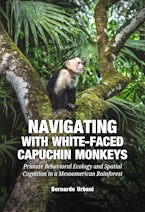This monograph examines a set of questions concerning human and nonhuman primate cognition, spatial memory, foraging behavior, and the ability of monkeys to form mental maps of the location and distribution of feeding and resting sites.
Two primary forms of spatial memory have been hypothesized for primates. First, it has been suggested that primates might represent spatial memory in the form of a coordinate-based (geometric) map in which points in the landscape are stored as true coordinates and individuals calculate precise angles and distances between targets. Alternatively, it has been suggested that primates may internally represent spatial information as a route-based (topological) map in which individuals use and reuse a set of common pathways and a select number of landmarks to reach a large number of targets.
This research examines questions of behavior and cognition in wild white-faced capuchins (Cebus imitator) in northeastern Costa Rica. First, a natural field study or behavioral-ecological study was carried out in which the diet, foraging behavior, activity budget, natural decision-making, and movement patterns of wild capuchins were documented. Secondly, an experimental field study was performed by placing feeding platforms in the forest to determine how capuchins integrate the spatial location of these new feeding sites into an internal representation and the degree to which travel routes are most consistent with a coordinate-based or a route-based spatial representation.
A major goal of this research is to develop an understanding of the challenges primates naturally face in locating resources that vary in time and space, and to identify the set of features that may have played a fundamental role in shaping the evolution of decision-making and spatial abilities in humans. In conclusion, the results suggest that capuchins use a route-based spatial representation in large-scale space and provide some evidence of a coordinate-based spatial representation in small-scale space.
DEDICATION
ACKNOWLEDGEMENTS
CHAPTER 1: INTRODUCTION
Objectives, Questions and Hypotheses of this Research
Capuchin Monkeys
Overview of the Research
CHAPTER 2: NAVIGATING THE LITERATURE: A THEORETICAL ASSESSMENT AND A REVIEW ON SPATIAL MAPPING IN PRIMATES
Types of Mental Maps
Exploring Spatial Memory in Wild Primates
Examining Spatial Representations in Capuchins
CHAPTER 3: STUDY SITE, STUDY GROUP, MATERIALS, AND METHODS
Study Site
Study Group
Data Collection
-Research Design: Natural Field Study (Behavioral-Ecological Phase) Research Design: Experimental Field Study (Field Experimental Phase)
-Data analysis
-Pilot study
-Ethical statement
-Data availability
CHAPTER 4: THE BEHAVIORAL ECOLOGY OF A GROUP OF WILD WHITE-FACED CAPUCHIN MONKEYS (CEBUS IMITATOR)
Materials and Methods
Results
-Activity budget
-Diet, feeding, and foraging behavior
-Ranging patterns
Discussion
-Activity budget
-Diet, feeding and foraging behavior
-Ranging patterns
CHAPTER 5: SPATIAL MAPPING IN WILD WHITE-FACED CAPUCHIN MONKEYS (CEBUS IMITATOR): A NATURAL FIELD STUDY
Results
-Pattern of feeding/resting tree visits and distribution
-Canopy density and forest profile: Field-of-view in the forest canopy
-A test of spatial memory: the case of the use of two feeding tree species.
-Evaluating travel itineraries
-Use of nodes, and route segments
-Reaching the major feeding/resting trees from different directions
Discussion
CHAPTER 6: SPATIAL MAPPING IN WILD WHITE-FACED CAPUCHIN MONKEYS (CEBUS IMITATOR): AN EXPERIMENTAL FIELD STUDY
Material and Methods
Results
Experiment 1
-Do white-faced capuchins visit experimental feeding platforms in the same order as they were first encountered?
-Do white-faced capuchins travel between sequential feeding platforms using a distance-minimizing principle, and over the course of the field experiment do they reduce their circuity index in traveling between experimental platforms?
-Do white-faced capuchins use traditional routes of travel to reach experimental feeding platforms or do they select novel travel routes?
-Do white-faced capuchins select nearer platforms over more distant platforms?
-Do white-faced capuchins exhibit a win-shift foraging rule when selecting experimental feeding platforms?
Experiment 2
-Do white-faced capuchins visit experimental feeding platforms in the same order as they were first encountered?
-Do white-faced capuchins travel between sequential feeding platforms using a distance-minimizing principle, and over the course of the field experiment do they reduce their circuity index in traveling between experimental platforms?
-Do white-faced capuchins use traditional routes of travel to reach experimental feeding platforms or do they select novel travel routes?
-Do white-faced capuchins select nearer platforms over more distant platforms? Do white-faced capuchins travel to more distant feeding platforms that contain higher food rewards preferentially over nearer feeding platforms that contain lower food rewards?
-Do white-faced capuchins exhibit a win-shift foraging rule when selecting experimental feeding platforms
Discussion
CHAPTER 7: CONCLUSIONS
REFERENCES
APPENDIX: THE STUDY AREA AT LA SUERTE BIOLOGICAL FIELD STATION (EBLS)
Bernardo Urbani is an Associate Researcher at the Center for Anthropology of the Venezuelan Institute for Scientific Research in Caracas, Venezuela. Currently, he also is a Fellow of the Alexander von Humboldt Foundation at the Leibniz Institute for Primate Research/German Primate Center in Göttingen, Germany. He received a grant from the National Science Foundation for conducting this study and was the recipient of the Early Career Achievement Award of the American Society of Primatologists and the Martha J. Galante Award of the International Primatological Society. His research interests are primate cognitive and behavioral ecology, history of primatology, archaeoprimatology/ethnoprimatology, and primate conservation.

